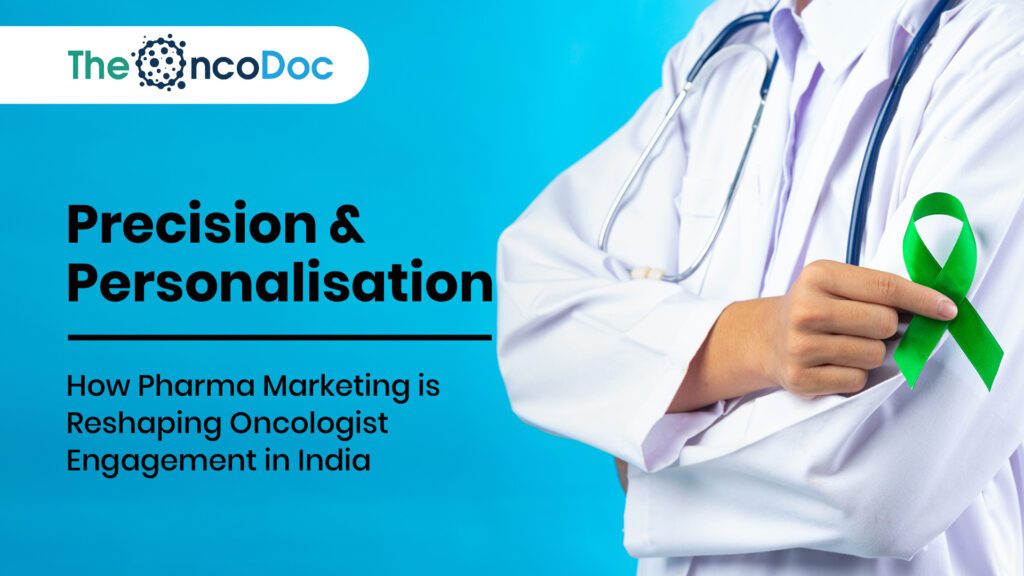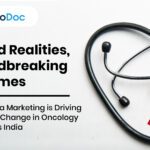Introduction: Beyond Prescriptions Partnering for Outcomes
Oncology is no longer just about the right drug at the right stage. In India’s evolving healthcare ecosystem, oncologists are at the heart of early detection, multidisciplinary collaboration, and survivorship planning. Yet, many feel overwhelmed by fast-evolving protocols, isolated practices, and insufficient support from ecosystem partners.
Pharma marketing must evolve from product-focused sales to value-focused partnerships. With AI, behavioural segmentation, and tailored knowledge support, pharma marketers now have the opportunity to become true allies of oncologists, not just vendors.
This article explores how precision pharma marketing is reshaping engagement with oncologists, empowering better decisions, earlier referrals, and deeper collaboration.
1. Why Oncologist Engagement Needs a New Playbook
Oncologists face a unique burden: they are decision-makers, educators, counsellors, and community advocates all in one. Traditional pharma detailing, however, remains focused on drug-centric value propositions, often missing the real needs of these specialists.
Takeaway: The message is clear—talk with oncologists, not at them.
2. From Product Push to Practice Support: The New Pharma Mission
Pharma brands that offer value beyond the molecule are building deeper relationships. Oncology marketers are now:
- Curating clinical digest content relevant to evolving guidelines.
- Providing patient education material that simplifies complex conditions.
- Enabling referral ecosystem building through digital tools.
- Supporting mental health content for both patients and providers.
This evolution requires hyper-personalised content delivered via the channels oncologists prefer.
3. AI-Powered Segmentation: Knowing the Oncologist Behind the Prescription
AI can now analyse oncologists’ practice patterns, patient loads, academic affiliations, digital behaviour, and content consumption history.
Applications:
- Customising content based on sub-speciality (e.g., breast vs hematologic).
- Timing outreach based on clinic hours or academic sessions.
- Predictive modelling to gauge likely interest in specific studies or trials.
🧠 Example:
A Tier 1 oncologist publishing on immunotherapy gets scientific briefings; a Tier 2 private practitioner gets vernacular explainer slides for patient conversations.
4. Channels that Work: Listening to the Oncologist’s Digital Preference
The days of assuming email works for all are over. Today’s oncologists are omnichannel, and pharma must adapt.
Strategic Insight: Digital-first, app-powered learning is now the default, not the alternative.
5. Dynamic Content Mapping: Relevance Over Repetition
Smart pharma campaigns now create layered content libraries, where AI delivers the right material based on the user’s past interactions:
- Skimmed video? Serve a full webinar.
- Opened guideline update? Share patient-facing resources next.
- Ignored brand info? Try peer-reviewed studies instead.
This Netflix-style model of intelligent content progression reduces fatigue and increases utility.
6. Local Language AI Content: Breaking the Barrier
India’s oncologists often serve patients from multiple linguistic zones. Pharma brands using AI to provide:
- Patient explainer videos in 10+ languages.
- Voice-bot tools for remote counselling.
- Localised WhatsApp templates with visuals and analogies.
🧠 Result:
Patients understand better → fewer follow-up calls → improved oncologist bandwidth and satisfaction.
7. Supporting the Referral Web: Empowering Generalists
Oncologists often receive late-stage referrals. Pharma can play a crucial role in fixing this pipeline.
By enabling GPs, gynaecologists, and ENT surgeons with:
- Early symptom red-flag kits.
- Referral logic models.
- Geo-specific risk alerts via SMS or apps.
Oncologists receive better-quality referrals, earlier in the disease cycle—a win-win for all.
8. AI Chatbots and Voice Assistants for Oncology Clinics
Many oncologists now use AI-driven assistants to streamline tasks:
- FAQ bots for patient family queries.
- Scheduling bots integrated with EMR systems.
- Prescription follow-up reminder engines.
Pharma marketers who offer or co-sponsor such tools become indispensable partners in practice management.
9. Emotional Intelligence: Aligning with Survivorship Goals
Treatment is one chapter; survivorship is a whole book. Oncology marketing must evolve to support:
- Mental health helplines.
- Return-to-work guides.
- Nutrition and sexual health resources.
🧠 Brands that enable oncologists to offer these tools gain long-term trust and engagement.
10. AI for KOL Strategy: Micro-Influencer Oncology
Every region has trusted voices, even if they’re not big on LinkedIn. AI can identify local KOLs based on:
- CME participation impact.
- WhatsApp group engagement rates.
- GP referrals are driven.
Finding “quiet giants” in local zones is where AI-driven KOL strategy beats traditional celebrity endorsements.
11. Co-Developing Tools with Oncologists
Smart pharma brands co-create tools with oncologists, not just for them:
- Screening eligibility calculators.
- Mutation-specific treatment explainers.
- Side-effect chatbot companions.
When oncologists feel a tool reflects their own workflow, adoption skyrockets.
12. Smart Feedback Loops: Let Data Refine the Dialogue
Modern marketing must listen more than it speaks. Using AI-based analytics:
- Track the most consumed topics.
- Drop underperforming content formats.
- A/B test messaging styles for clarity.
🧠 Result: Every month, the campaign gets sharper—like a conversation, not a monologue.
13. Crisis-Ready Campaigns with Predictive AI
If search trends in a region spike for “blood in cough,” that’s not just a digital signal, it’s a cancer red flag. Pharma brands must:
- Deploy emergency awareness ads.
- Notify local oncologists.
- Share updated triage protocols with GPs.
AI enables response speed a new KPI in oncology engagement.
14. Clinical Trial Awareness & Pre-Screening Tools
Many Indian oncologists underuse clinical trials due to a lack of awareness or logistical support.
Pharma can bridge this with:
- Region-wise trial eligibility dashboards.
- Automated patient prescreening bots.
- CME content focused on research enrollment.
The message shifts from “try our brand” to “let’s advance science together.”
15. Benchmarking Oncology Campaign Funnels
Let’s compare an AI-optimised campaign targeting Tier 2 oncologists with traditional ones.
Insight: AI-enhanced targeting nearly doubles the engagement and referral outcomes.
16. The Future: AI Co-Pilots for Oncologist Engagement Teams
Soon, pharma sales and med-ed teams will work side-by-side with AI copilots that:
- Suggest next-best content for each doctor.
- Optimise meeting timing based on past response.
- Flag clinicians whose practices align with new molecules or trials.
This is not just sales enablement it’s care enablement.
17. Omnichannel vs. Multichannel: Why Integration Wins
While many pharma brands still operate in silos, separating rep visits, email campaigns,and webinars, successful oncology marketing is shifting to omnichannel orchestration.
Multichannel = parallel efforts.
Omnichannel = connected experiences.
AI platforms can ensure continuity, such as:
- A doctor receives a CME invite → attends → gets a personalised summary → receives patient resources → receives a feedback prompt.
This unified journey increases recall, builds trust, and eliminates content fatigue.
18. Real-World Evidence Sharing for Practice Impact
Oncologists today want real-world evidence (RWE) that reflects their patient populations, not just global trial data. Pharma marketers can lead by:
- Sharing localised outcomes from post-market surveillance.
- Providing district-wise efficacy dashboards.
- Delivering case-based webinars with peer panellists.
🧠 Impact: Oncologists become more confident in integrating newer treatments, especially in Indian patient cohorts.
19. AI in Ethical Guardrails for Marketing
With rising sensitivity around patient data and HCP preferences, pharma must use AI ethically and transparently:
- Auto-suppress messaging to disengaged doctors.
- Ensure AI only suggests content based on declared speciality/consent.
- Use opt-in, anonymised engagement data, not surveillance-based metrics.
Ethical AI isn’t just compliance, it’s brand character in action.
20. Data-Driven Rep Visits: From Cold Calls to Smart Calls
Sales reps armed with AI dashboards can now:
- See the oncologist’s past engagements.
- Know what content they liked/shared.
- Align pitch to current trial interests or patient burden.
Key Insight: Smart data transforms reps from sellers to solution providers.
21. Oncology App Ecosystems: Creating a Daily Companion
Rather than sending fragmented messages, pharma brands are now building companion apps or integrating with existing ones (like Hidoc, Curofy, etc.).
These apps offer:
- Daily alerts on new protocols or regional stats.
- Access to quick diagnostic tools or calculators.
- CME trackers and certification badges.
- Patient management content.
When these apps become part of the oncologist’s daily workflow, brand affinity becomes organic, not forced.
Conclusion: The Power of Precision Marketing in Oncology
India’s oncologists need more than molecules; they need intelligence, empathy, and partnership. Pharma brands that evolve into value partners using AI, content personalisation, and human-first design will build trust, engagement, and ultimately, better outcomes.
🚀 The Future-Ready Oncology Marketer Will:
✅ Engage via app-first, low-fatigue channels
✅ Offer co-created, regionally relevant content
✅ Map referral flows and support upstream education
✅ Be a survivorship ally, not just a prescriber’s rep
Because in oncology, the most effective marketing isn’t the loudest—it’s the most aligned.
The Oncodoc team is a group of passionate healthcare and marketing professionals dedicated to delivering accurate, engaging, and impactful content. With expertise across medical research, digital strategy, and clinical communication, the team focuses on empowering healthcare professionals and patients alike. Through evidence-based insights and innovative storytelling, Hidoc aims to bridge the gap between medicine and digital engagement, promoting wellness and informed decision-making.



